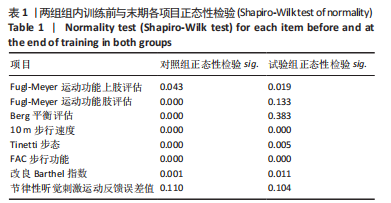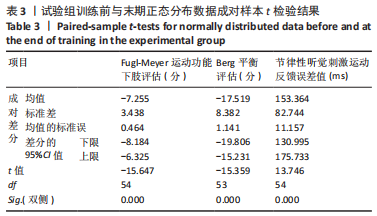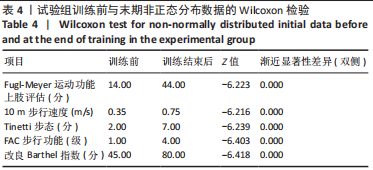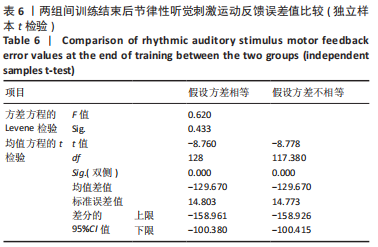中国组织工程研究 ›› 2023, Vol. 27 ›› Issue (35): 5583-5588.doi: 10.12307/2023.952
• 组织构建临床实践 clinical practice in tissue construction • 上一篇 下一篇
节律性听觉刺激干预脑卒中患者非急性期的运动障碍
刘世文1,刘全丰1,杨知博2,段长秋3,张宝莹3,谭 悦3,艾长山4,姜慧强5,冯绪刚6,孔年化7
- 1深圳恒生医院康复科,广东省深圳市 518102;2海南健康管理职业技术学院康复系,海南省海口市 571900;3长春人文学院康复系,吉林省长春市 130117;4吉林省中医药研究院附属医院康复科,吉林省长春市 130021;5吉林省人民医院康复科,吉林省长春市 130021;6吉林市龙潭中医院,吉林省吉林市 132000;7深圳市龙岗区儿童智力康复中心,广东省深圳市 518116
Rhythmic auditory stimulation for non-acute dyskinesia in stroke patients
Liu Shiwen1, Liu Quanfeng1, Yang Zhibo2, Duan Changqiu3, Zhang Baoying3, Tan Yue3, Ai Changshan4, Jiang Huiqiang5, Feng Xugang6, Kong Nianhua7
- 1Department of Rehabilitation, Shenzhen Hengsheng Hospital, Shenzhen 518102, Guangdong Province, China; 2Department of Rehabilitation, Hainan Health Management College, Haikou 571900, Hainan Province, China; 3Department of Rehabilitation, Changchun Humanities and Sciences College, Changchun 130117, Jilin Province, China; 4Department of Rehabilitation, Affiliated Hospital of Jilin Academy of Traditional Chinese Medicine, Changchun 130021, Jilin Province, China;
摘要:
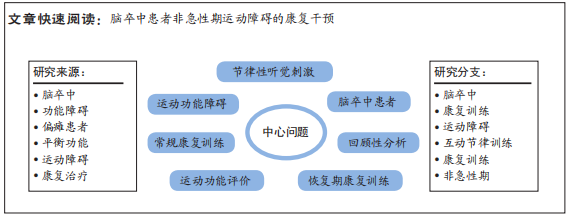
文题释义:
节律性听觉刺激:主要是用节律性声音(音频)信号反复刺激听觉的训练,改善人的运动和认知行为异常的训练技术。在20世纪末,受音乐、舞蹈节律的启发,用音频改善患者认知、运动行为障碍,当时曾经以互动节拍器IM命名该技术。推测其机制与大脑功能网络同步化及注意力有关,目前用节律性谐振理论解释是热点,认为节律性听觉刺激信号可以和肢体运动频率产生节律性共振,能够提升运动能力。下肢运动功能障碍:人类下肢是整个身体的基础支撑,对身体其他部位的平衡、支撑和稳定起到关键的作用,其功能表现在站立、走步、跑步、跳跃、爬楼梯、坐下和站起等。如有下肢功能障碍,则表现在双侧协调性、起步快慢、抬足高度、步长、步宽度、步态对称性、步伐连续性、行走路程、躯干稳定性、行走速度、足蹬力、足底压力分布等方面的异常。
背景:近些年来,国外已将互动节律性听觉刺激用于康复治疗中枢神经损伤导致的运动行为障碍,中国康复医学界也陆续开展这方面的应用研究,但是将互动节律性听觉刺激用于脑卒中非急性期运动障碍的研究报道颇少。
目的:研究节律性听觉刺激对脑卒中患者非急性期运动障碍的影响。
方法:纳入2017年3月至2019年10月深圳恒生医院、吉林省中医药研究院附属医院、吉林省人民医院、吉林市中西医结合医院及吉林市龙潭中医院康复科的脑卒中偏瘫患者130例,年龄40-80岁,采用随机数字表法分为对照组(n=75)与试验组(n=55),对照组进行常规的康复训练(1次/d,5次/周),试验组在常规康复训练的基础上进行互动节律性听觉刺激训练(1次/d,5次/周),共训练8周。训练及训练结束后,评估两组患者Fugl-Meyer运动功能、Berg平衡、10 m步行速度、Tinetti步态、FAC步行功能、节律性听觉刺激运动反馈误差值及改良Barthel指数。
结果与结论:①训练结束后,两组患者的Fugl-Meyer运动功能、Berg平衡、10 m步行速度、Tinetti步态、FAC步行功能、节律性听觉刺激运动反馈误差值及改良Barthel指数评估结果均较训练前明显改善(P=0.000);②训练结束后,试验组患者的Fugl-Meyer运动功能、Berg平衡、Tinetti步态、FAC步行功能、节律性听觉刺激运动反馈误差值及改良Barthel指数评估结果均优于对照组(P=0.000),两组间10 m步行速度比较差异无显著性意义(P > 0.05);③结果显示,互动节律性听觉刺激训练是改善脑卒中恢复期和后遗症期患者运动障碍的有效康复方法,互动节律性听觉刺激对患者步行速度的作用尚需探讨。
https://orcid.org/0000-0003-2431-3055 (刘世文)
中国组织工程研究杂志出版内容重点:组织构建;骨细胞;软骨细胞;细胞培养;成纤维细胞;血管内皮细胞;骨质疏松;组织工程
中图分类号:

